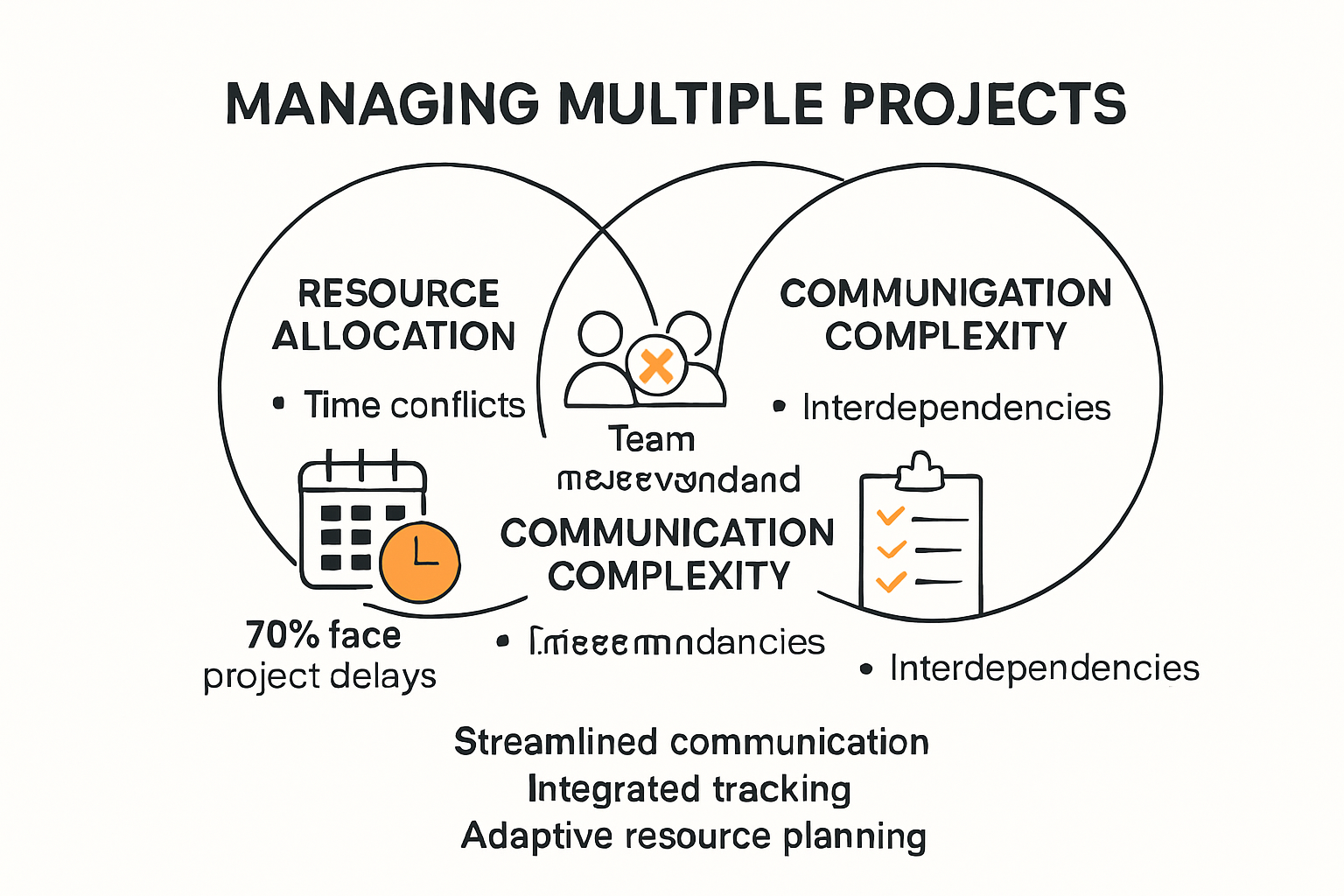Juggling multiple projects at once might look impressive on a resume and yet it can quickly turn even the most experienced team into a tangle of missed deadlines and competing priorities. Here is what most people don’t see. Over 70 percent of organizations struggle with project delays and resource conflicts when handling more than one major initiative at a time. The real breakthrough comes from using strategic tools and fresh prioritization tactics that not only keep projects on track but actually boost team morale in the process.
Table of Contents
- Common Challenges When Managing Multiple Projects
- Effective Prioritization And Resource Allocation
- Best Tools And Techniques For Project Organization
- Tips For Leading Teams Across Several Projects
Quick Summary
| Takeaway | Explanation |
|---|---|
| Prioritize projects strategically | Select projects that align with organizational goals and potential return on investment for better resource utilization. |
| Implement robust communication frameworks | Establish clear communication channels and regular updates to ensure team alignment and reduce misunderstandings. |
| Adopt advanced resource allocation techniques | Use flexible, data-driven methods to adapt resource distribution in real-time based on project needs. |
| Monitor performance and progress effectively | Implement integrated tracking systems to maintain visibility and prevent bottlenecks across multiple projects. |
| Promote team well-being to prevent burnout | Set clear capacity limits and monitor workloads to maintain a balanced team environment and enhance productivity. |
Common Challenges When Managing Multiple Projects
Managing multiple projects simultaneously presents complex organizational challenges that can quickly overwhelm even experienced professionals. Project managers and business leaders frequently encounter intricate obstacles that threaten project success and team productivity.

Resource Allocation and Conflict Management
One of the most significant challenges in managing multiple projects is effectively allocating limited resources. Research from Project Management Institute reveals that strategic resource allocation requires a comprehensive portfolio approach to address inter-project dependencies and potential conflicts.
Resource constraints create substantial pressure on teams. When professionals are stretched across multiple initiatives, they experience:
- Competing Priorities: Team members struggle to determine which project deserves immediate attention
- Overload Potential: Individuals risk burnout from simultaneous project demands
- Performance Degradation: Divided focus can compromise the quality of work across all projects
Communication and Coordination Complexity
A comprehensive study on healthcare research project management highlighted that ineffective communication represents a critical challenge in multi-project environments. Project managers must develop robust communication strategies that provide transparency and clarity across different initiatives.
Common communication barriers include:
- Misaligned project timelines
- Inconsistent reporting mechanisms
- Lack of centralized information sharing
- Unclear escalation protocols
These communication challenges can lead to significant project delays, misunderstandings, and potential conflicts between team members and stakeholders.
Status Tracking and Performance Monitoring
Tracking progress across multiple projects requires sophisticated monitoring techniques. Organizations often struggle with maintaining real-time visibility into project statuses, which can result in unexpected bottlenecks and missed deadlines.
Key performance tracking challenges involve:
- Inconsistent progress measurement
- Difficulty in identifying potential risks early
- Limited ability to predict project outcomes
- Complex interdependencies between projects
To address these challenges effectively, project managers need integrated task management strategies for modern leaders. Implementing robust tracking mechanisms and adopting flexible management approaches can help mitigate these common obstacles.
To highlight the typical challenges faced in multi-project management, the following table summarizes the main issues along with their impact as described in the article.
| Challenge | Description | Impact |
|---|---|---|
| Competing Priorities | Struggling to determine which project deserves immediate attention | Increased delays and confusion |
| Overload Potential | Team members risk burnout from project demands | Reduced productivity, burnout risk |
| Performance Degradation | Divided focus across projects | Lower quality and errors |
| Communication Barriers | Issues with timelines, reporting, and info sharing | Misunderstandings, project delays |
| Inconsistent Status Tracking | Difficulty tracking progress across projects | Bottlenecks, missed deadlines |
| Complex Interdependencies | Projects depend on each other’s outcomes | Increased risks and coordination needs |
Successful multi-project management demands a strategic approach that balances resource allocation, communication efficiency, and performance monitoring. By recognizing these challenges and developing targeted solutions, organizations can transform potential barriers into opportunities for enhanced productivity and team collaboration.
Effective Prioritization and Resource Allocation
Prioritizing projects and allocating resources strategically represents a critical skill for organizations seeking to maximize productivity and achieve strategic objectives. Without a systematic approach, teams risk spreading themselves too thin, compromising project quality and overall organizational performance.
Strategic Project Selection Methodology
Research from project management experts emphasizes the importance of selecting projects that align closely with organizational goals and demonstrate potential for maximum return on investment. Effective project prioritization involves a comprehensive evaluation process that considers multiple critical factors.
Key criteria for project selection include:
- Strategic Alignment: Direct connection to organizational objectives
- Resource Requirements: Estimated time, budget, and personnel needed
- Potential Impact: Anticipated benefits and long-term value
- Risk Assessment: Potential challenges and mitigation strategies
Successful organizations develop a structured framework that objectively scores and ranks potential projects. This approach helps prevent emotional decision-making and ensures resources are allocated based on data-driven insights.
Advanced Resource Allocation Techniques
A simulation-based research study introduced innovative approaches to multi-project scheduling, demonstrating that sophisticated priority rules can significantly improve resource utilization. Project managers must move beyond traditional allocation methods and adopt more dynamic, flexible strategies.
Effective resource allocation techniques involve:
- Implementing real-time tracking systems
- Creating flexible resource pools
- Developing cross-functional team capabilities
- Establishing clear priority protocols
The goal is to create a responsive allocation system that can quickly adapt to changing project demands and organizational needs. This requires continuous monitoring and willingness to redistribute resources as project dynamics evolve.
Balancing Workload and Preventing Burnout
Healthcare research project management studies highlight the critical importance of preventing team overload. Effective prioritization is not just about selecting the right projects but also about maintaining team well-being and preventing burnout.
Strategies for balanced workload management include:
- Implementing clear capacity limits
- Rotating high-intensity project assignments
- Providing adequate support and resources
- Monitoring individual and team stress levels
To streamline your task management and project tracking, consider developing a comprehensive system that provides visibility into team capabilities and project demands.

Ultimately, effective prioritization and resource allocation require a holistic approach that balances organizational goals, team capabilities, and individual well-being. By developing a systematic, data-driven methodology, organizations can optimize their project portfolio and drive sustainable success.
Best Tools and Techniques for Project Organization
Effective project organization requires a strategic approach that combines sophisticated tools, proven techniques, and adaptable management methodologies. Research from the Project Management Institute emphasizes the critical importance of standardized processes and centralized information systems for managing complex project portfolios.
Digital Project Management Platforms
Modern organizations rely on advanced digital tools to streamline project coordination and enhance team collaboration. These platforms offer comprehensive features that go beyond traditional project tracking, providing real-time insights and integrated workflow management.
Key features of effective project management platforms include:
This table organizes the key features of effective digital project management platforms mentioned in the article, clarifying their functions and benefits for managing multiple projects.
| Platform Feature | Function | Benefit |
|---|---|---|
| Centralized Dashboard | Single view of all project statuses | Improves visibility and oversight |
| Resource Allocation Tracking | Real-time monitoring of team workloads | Prevents overload, ensures fair distribution |
| Collaborative Communication Tools | Integrated messaging and file sharing | Enhances team coordination and transparency |
| Automated Reporting | Instant generation of progress and performance metrics | Saves time, enables quick decision-making |
- Centralized Dashboard: Single view of all project statuses
- Resource Allocation Tracking: Real-time visibility into team workloads
- Collaborative Communication Tools: Integrated messaging and file sharing
- Automated Reporting: Instant generation of progress and performance metrics
By implementing robust project tracking strategies, organizations can transform their project management approach from reactive to proactive.
Prioritization and Workflow Techniques
Successful project organization extends beyond technological tools. Professionals must develop structured techniques for managing complex project portfolios. Critical methodologies include:
- Kanban Boards: Visual representation of project stages and workflow
- Agile Methodologies: Flexible, iterative approach to project management
- Critical Path Analysis: Identifying and managing project dependencies
- Time-Boxing: Allocating fixed time periods for specific project tasks
These techniques help teams maintain clarity, reduce bottlenecks, and ensure consistent progress across multiple initiatives.
Integration and Automation Strategies
Advanced project management demands seamless integration between different tools and platforms. Organizations increasingly rely on automation to reduce administrative overhead and minimize human error.
Effective integration strategies involve:
- Connecting project management platforms with communication tools
- Implementing workflow automation scripts
- Creating cross-platform data synchronization
- Developing custom integration solutions
Automation not only saves time but also provides more accurate and real-time insights into project performance. Teams can focus on strategic work while repetitive tasks are handled efficiently.
Successful project organization is a dynamic process that requires continuous adaptation. By combining sophisticated digital tools, structured methodologies, and intelligent integration strategies, organizations can create a robust framework for managing complex project portfolios. The key lies in selecting flexible solutions that can evolve with changing business needs and technological advancements.
Tips for Leading Teams Across Several Projects
Leading teams across multiple projects demands exceptional leadership skills, strategic communication, and adaptable management techniques. Research from the Project Management Institute underscores the critical importance of developing integrated and unified project teams through continuous team-building and collaborative approaches.
Establishing Clear Communication Frameworks
Effective communication represents the cornerstone of successful multi-project leadership. Project managers must create robust communication frameworks that ensure transparency, alignment, and consistent information flow across different initiatives.
Key communication strategies include:
- Regular Synchronized Meetings: Scheduled check-ins that connect team members across projects
- Centralized Communication Platforms: Single channels for sharing updates and insights
- Transparent Progress Reporting: Clear, consistent mechanisms for tracking project developments
- Open Feedback Channels: Mechanisms for team members to share challenges and suggestions
Project tracking strategies can help leaders maintain comprehensive visibility into team performance and project dynamics.
Collaborative Leadership and Team Dynamics
Collaborative project leadership research highlights the necessity of fostering strong interpersonal relationships and problem-solving capabilities within project teams. Successful leaders recognize that managing multiple projects requires more than technical skills.
Essential collaborative leadership techniques involve:
- Developing shared decision-making processes
- Creating cross-functional learning opportunities
- Encouraging knowledge sharing between project teams
- Building trust through transparent management
Leaders must invest time in understanding individual team member strengths, potential challenges, and professional development needs across different projects.
Priority Setting and Resource Management
Research published in healthcare project management emphasizes the importance of implementing clear priority rules when managing complex, limited-resource projects. Project leaders must develop systematic approaches to resource allocation and workload distribution.
Priority management strategies include:
- Establishing clear project hierarchy
- Creating flexible resource allocation models
- Implementing periodic project portfolio reviews
- Developing contingency plans for unexpected challenges
Successful multi-project leadership requires a holistic approach that balances team capabilities, organizational objectives, and individual professional growth. By cultivating robust communication frameworks, embracing collaborative leadership, and implementing strategic priority management, project managers can effectively guide teams through complex, multi-project environments.
The most successful leaders recognize that managing multiple projects is not just about technical execution but about creating an adaptive, supportive ecosystem where teams can thrive and deliver exceptional results.
Frequently Asked Questions
What are the common challenges when managing multiple projects?
Managing multiple projects often leads to resource allocation conflicts, communication complexity, and difficulties in status tracking. Teams may face competing priorities, risk of burnout, and a degradation in performance due to divided focus across projects.
How can I prioritize projects effectively?
Effective project prioritization involves evaluating projects based on strategic alignment with organizational goals, resource requirements, potential impacts, and risk assessments. A structured framework to score and rank projects can help guide decision-making.
What tools can help with managing multiple projects?
Digital project management platforms provide centralized dashboards, real-time resource allocation tracking, collaborative communication tools, and automated reporting capabilities. These features enhance visibility, coordination, and efficiency across multiple initiatives.
How can leaders support teams managing several projects?
Leaders can support teams by establishing clear communication frameworks, encouraging collaborative leadership, and implementing systematic priority setting and resource management strategies. Promoting team well-being and preventing burnout is also crucial for maintaining productivity.
Conquer Complex Project Management With Gammatica
Are you overwhelmed by competing priorities, resource conflicts, and endless status tracking while managing multiple projects at once? The strategies you discovered above work best when paired with professional tools that make organization, communication, and automation simple. Gammatica is built around the reality that project bottlenecks, administrative overload, and team burnout are major barriers to your success. It takes project management from stressful and scattered to efficient and unified with AI-driven workflows, priority setting, and real-time collaboration—all in one place.

Experience for yourself how Gammatica lets you quickly balance resources, automate communication, and streamline multi-project tracking. See how our project tracking strategies unlock up to 16 extra hours each week and help teams stay productive, motivated, and on track. Don’t let complexity hold your business back. Take control today by starting your journey on Gammatica and discover how effortless multi-project leadership can be.
Recommended
- Project Progress Tracking: Strategies for Success in 2025 | Gammatica
- How to Manage Tasks Effectively in 2025: Proven Strategies for Leaders | Gammatica
- Lead Management for Beginners: 2025 Guide for Teams and Leaders | Gammatica
- Collaborative Decision Making for Leaders: Strategies for 2025 | Gammatica



